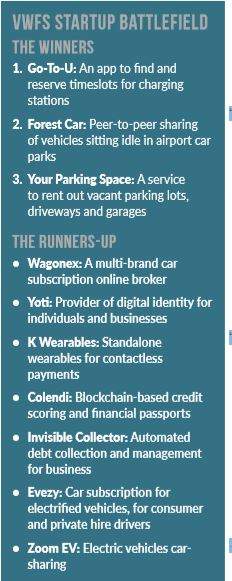
Volkswagen’s captive is tapping into startups to keep pace with changing consumer models. Lorenzo Migliorato caught up with the pitching businesses to hear their views on automotive’s present and future.
The digitisation of customer data and near-complete penetration of mobile connectivity have finally brought the digital revolution to that century-old asset: the car. And its champions have taken notice.
Events like Volkswagen Financial Services’ (VWFS) Startup Battlefield, which in July saw young companies pitch their ideas to a panel of VWFS executives and venture capitalists in Milton Keynes, seek to bring financial services and 21st century innovators together to work on sustainable products that benefit both sides.
“The whole point of this is around bringing together the large corporates’ customer base know-how, and the agility, innovation and platforms that new businesses have,” says Nathan Thompson, digital and innovation director at VWFS UK, one of the minds behind the event’s UK edition. “Events like this are really pivotal in bringing together that base.” It may be counter-intuitive that giants such as Volkswagen, with massive R&D budgets and ambitious visions for the future, need to tap into one- or two-year-old startups.
But as Thompson explains, the synergies generated from such partnerships may be the only way OEMs have of adapting fast enough to shifting consumer demands. “What makes these [startups] so appealing is their agility,” he says.
“These guys are able to fail fast, learn quickly – and learn those lessons in an environment that is much more amiable to risk than we are, maybe.I think bringing the best of two worlds together here is really important in terms of how we position ourselves in the market.” Rival carmakers have been experimenting with the startup competition format too – BMW’s UK Innovation Lab marked its second edition this year. And VWFS UK’s own event followed on from the first edition in Lisbon – an emerging hub for web development – in July 2017.
How well do you really know your competitors?
Access the most comprehensive Company Profiles on the market, powered by GlobalData. Save hours of research. Gain competitive edge.

Thank you!
Your download email will arrive shortly
Not ready to buy yet? Download a free sample
We are confident about the unique quality of our Company Profiles. However, we want you to make the most beneficial decision for your business, so we offer a free sample that you can download by submitting the below form
By GlobalDataImporting the event to the UK was not for a mere change of scenery, however. Thompson says it resulted in a different set of startups, which might be of interest to a different audience within the VW group.
Of note is the number of finance- and leasing-focused startups in the Milton Keynes event’s line-up: six out of 10, compared to none in Lisbon. “I think, in the future, the finance business and payments in general will become much more prevalent as we move to a mobility and connected ecosystem,” Thompson says.
Automotive is increasingly experimenting with pay-as-you-go and subscription-based products, and the transactional element will give “the captives and finance providers a much more prominent role than they might previously have had”. “Everything in the future is going to be payment-driven – parking, transport, travel and mobility services, and the vehicle itself. I see a heavy role for payments and finance.”
And true enough that is also the view of more than one of the event’s participants. “The world is moving towards monthly payments, towards fixed monthly fees rather than paying upfront,” so the finance model, which captives have been pioneering for decades in the consumer space, is an excellent fit, says Rob Jolly, founder of electric vehicle subscription provider Evezy.
The shift to transaction-based, pay-as-yougo services has coincided with heightened public awareness of financial vulnerability in the wake of the credit crunch. Many – though not all – of the teams behind the competing startups were born in the late 1980s to mid1990s, and came of age around 2008. “We need to understand what happened
in 2008, what is happening in 2018, and perhaps find new ways, not to give finance, but to lend money, or to lend something,” says Miguel Rangel, chief financial officer at Invisible Collector, a Portugal-based B2B debt management software house.
“I think [the mobility-oriented businesses] are doing a fantastic job of shifting from financing to a very good product [allowing] families to continue using their cars.” Such products – particularly the more flexible, mobility-based ones like car-sharing – pose challenges to an industry like carmaking, which has spent a century cultivating brand image and its association to social status. “The whole way in which commercial entities need to engage with consumers is fundamentally changing. Products are becoming less important as they become service orientated,” says Jon Pocock, consultant to digital identity provider Yoti.
“That will change the way credit products, or any form of credit decision is taken.” If everyday services are going to be revolving around credit-like models, financial eligibility needs to expand, not shrink. Assessments can – and need to – involve broader parameters than now, say Pocock and Eray Eren, co-founder of Colendi, a developer of decentralised credit reference software.
Things like being able to save £50 or £100 a month from one’s disposable income, or never defaulting on payments under a hire agreement, should become “tangible” in one’s credit history – what Pocock calls an “experience model” as opposed to a “flat” credit evaluation. “Creditworthiness is not only financial,” Eren adds. “It is also behavioural.” Getting up and close with an industry incumbent like VWFS is not just a way of presenting a different perspective on customers’ credit profiles: it can potentially extend the captive’s client base.
For the startups, it is also an occasion to build up a special relationship with a major OEM. Cars are assets with relatively high procurement cost and laden with risk – particularly when shared among multiple users. By partnering with one or a select few OEMs, procurement could be streamlined and cheaper. “There are lots of procurement channels, and partnering with a company like VWFS, part of a car supplier, is a fantastic opportunity,” says Toby Kernon, founder of car subscription
provider Wagonex.
Incidentally, another UK car subscription broker, Drover, participated in BMW’s startup event in 2017, and subsequently partnered for the long-term. The businesses on the stage at Milton Keynes are ambitious, but a far cry from the stereotype of the arrogant disruptor. They know they need the support of incumbents to scale up and for their model to consolidate. “If you think about car platforms, corporate car-sharing, people doing miles, especially with low-emission vehicles, you have got to have [the backing of] a manufacturer who has the right products,” says Greg Fairbotham, founder of low-emission car club Zoom EV.
“At the moment I don’t think there are an awful lot of them. I guess it depends on the likes of VW engaging with the [partner] business from the beginning, really – whether they take an open or more direct approach.”
In a sense, it might sound odd that VWFS– which in most other industries would be the incumbent ripe for disruption – would try to tap into business models that are all about flexibility, the ability to switch and, to an extent, brand-agnostic.
An often-cited benefit of leasing, on the industry’s part, is its customer-retention potential – so is a commitment-free service like Wagonex or Evezy not its very antithesis? As a carmaker, “you need to make sure they [customers] come back to you,” says Zoom’s Fairbotham, adding that mere financing is a purely money-based way of retaining customers, and the vision should be wider. “That responsibility falls within the manufacturer, and that is the challenge. “[The market] moved from buying cars outright to PCP, and we managed that transition. It is now moving to things like subscription. It’s all about coming out with new ways to manage that. It is down to the captives to come up with an innovative solution in order to move with the market.”








